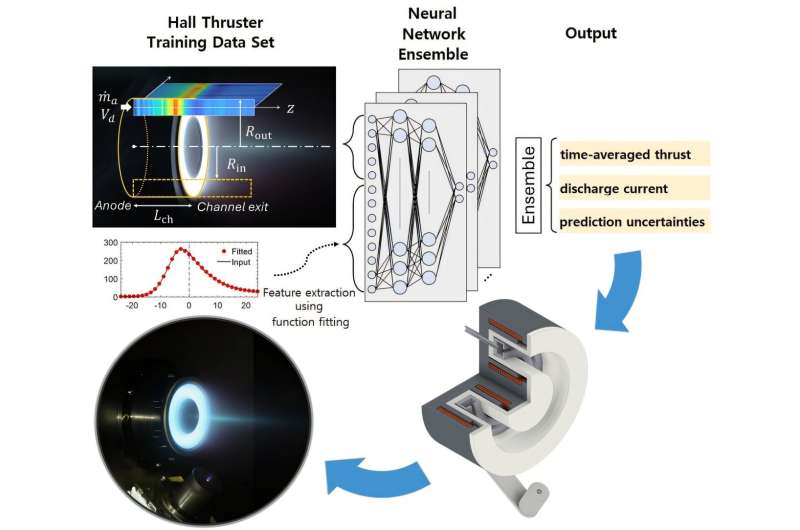A Hall thruster is a high-efficiency propulsion device using plasma that is used for various difficult space missions, such as SpaceX’s constellation satellites, Starlink and NASA’s asteroid probe, Psyche, and is one of the core space technologies.
KAIST researchers will be verifying the performance of the Hall thruster for CubeSats developed using artificial intelligence techniques by loading it onto the CubeSat K-HERO during the fourth launch of Nuri scheduled for November of this year.
Professor Wonho Choe of the Department of Nuclear and Quantum Engineering developed an artificial intelligence technique that can predict the thrust performance of Hall Effect ion thrusters (i.e., Hall thrusters), which are engines for satellites or space probes, with high accuracy. The study is published in the journal Advanced Intelligent Systems.
Hall thrusters have high fuel efficiency, so they can greatly accelerate satellites or spacecraft using less propellant (fuel), and can generate large thrust relative to the power consumed. Based on these advantages, it is widely used for various missions, such as maintaining formation flight of satellite clusters in space environments where propellant conservation is important, orbital deorbit maneuvers for reducing space debris, and providing propulsion for deep space exploration such as comet or Mars exploration.
Recently, as the space industry has expanded in the era of Newspace, space missions are becoming more diverse and the demand for Hall thrusters is increasing accordingly. In order to quickly develop high-efficiency Hall thrusters optimized for each unique mission, a technique to accurately predict the performance of the thruster from the design stage is essential.
However, existing methods have limitations such as not being able to precisely handle the complex plasma phenomenon occurring in the Hall thruster or being limited to specific conditions, resulting in low performance prediction accuracy.

The research team developed a highly accurate thruster performance prediction technique based on artificial intelligence that drastically reduces the time and cost required for repetitive work of designing, manufacturing, and testing the Hall thruster.
Professor Choe’s team, which started the first domestic electric thruster development research in 2003 and has been leading related research and development, introduced an artificial neural network ensemble structure based on 18,000 Hall thruster learning data generated using a self-developed electric thruster computer analysis tool and applied it to predicting thrust performance.
The computer analysis tool developed to secure high-quality learning data models plasma physics and thrust performance. The accuracy of the computer analysis tool was verified to be high, with an average error of less than 10% compared to approximately 100 experimental data performed with 10 Hall thrusters developed for the first time in Korea by the research team.
The artificial neural network ensemble model operates as a digital twin model that can predict thruster performance in a short period of time, within a few seconds, with high accuracy depending on the design variables of the Hall thruster.
In particular, it can analyze in detail the changes in performance indicators such as thrust and discharge current according to design variables such as fuel flow rate and magnetic field that were difficult to analyze with previously known scaling laws.

The research team showed that the AI neural network model developed this time showed an average error of less than 5% for the 700W and 1kW class Hall thrusters developed in-house, and an average error of less than 9% for the 5kW class high-power Hall thruster developed by the US Air Force Research Laboratory. This study proved that the AI prediction technique developed can be widely applied to Hall thrusters of various power sizes.
Professor Choe said, “The AI-based performance prediction technique developed by the research team has high accuracy and is already being used to analyze the thrust performance of Hall thrusters, which are engines for satellites and spacecraft, and to develop high-efficiency, low-power Hall thrusters. This AI technique can be applied not only to Hall thrusters, but also to the research and development of ion beam sources used in various industries such as semiconductors, surface treatment, and coating.”

In addition, Professor Choe explained, “The Hall thruster for the cube satellite developed using AI techniques in collaboration with Cosmo Bee Co., Ltd., an electric propulsion specialist and a laboratory startup of the research team, will be installed on the 3U (30x10x10 cm) cube satellite K-HERO in the 4th launch of Nuri scheduled for November of this year to verify its performance in space.”
The results of this study, in which Ph.D. student Jaehong Park of KAIST Department of Nuclear and Quantum Engineering (Space Exploration Engineering Interdisciplinary Major) participated as the first author, were recognized for their innovation by being selected as the journal’s front cover paper.
More information:
Jaehong Park et al, Predicting Performance of Hall Effect Ion Source Using Machine Learning, Advanced Intelligent Systems (2024). DOI: 10.1002/aisy.202400555
Citation:
AI technique predicts Hall thruster power for spacecraft with high accuracy (2025, February 3)
retrieved 3 February 2025
from https://phys.org/news/2025-02-ai-technique-hall-thruster-power.html
This document is subject to copyright. Apart from any fair dealing for the purpose of private study or research, no
part may be reproduced without the written permission. The content is provided for information purposes only.

